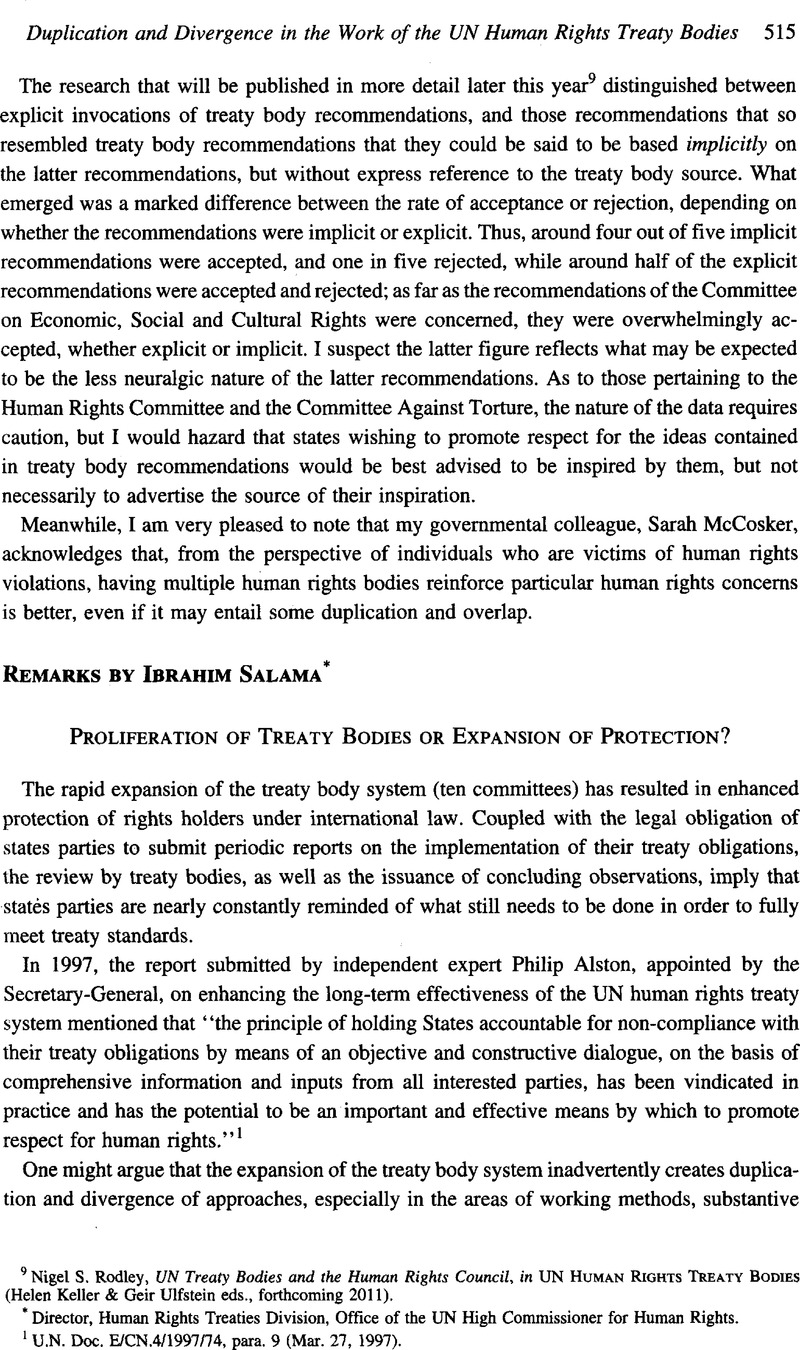Published online by Cambridge University Press: 28 February 2017

1 U.N. Doc. E/CN.4/1997/74, para. 9 (Mar. 27, 1997).
2 For an overview, see U.N. Doc. HRI/ICM/2010/2, entitled Report on the Working Methods of the Human Rights Treaties Bodies (May 10, 2010), available at http://www2.ohchr.org/english/bodies/icm-mc/documentsll.htm.
3 The seventh ICM meeting, in June 2008, “noted the usefulness of exploring the possibility of issuing joint general comments. It encouraged treaty bodies to actively consider the discussion and adoption of joint general comments and reiterated that such general comments should only refer to common thematic issues, not treaty provisions.” U.N. Doc. A/63/280, at 24 (Aug. 13, 2008).
4 The tenth ICM meeting, in November-December 2009, reiterated the recommendation of previous meetings that each treaty body consider adopting a procedure within a reasonable time period. Such a procedure could include a request to states parties to respond, within a designated period of time, to priority issues identified by the committee. It recommended that reminders be sent to states parties who do not respond to the request for information within a given deadline, in accordance with the decision by each treaty body. It recommended that the follow-up procedure of each treaty body be undertaken in a transparent manner and therefore be considered a public procedure. It also recommended that a separate webpage on follow-up be created for each treaty body to include such information. U.N. Doc. A/65/190, at 21-22 (Aug. 6, 2010).
5 This mechanism is chaired by the Office of the High Commissioner for Human Rights and focuses on (1) promoting a coordinated and coherent UN system-wide approach toward the integration of human rights principles and international standards into UN operational activities for development; (2) providing coherent support for Resident Coordinators and UN Country Teams in mainstreaming human rights; (3) developing a coherent UN system-wide approach, through cooperation and collaboration among UN agencies, to providing support toward strengthening national human rights protection systems at the request of governments; and (4) contributing to the integration of human rights issues in the overall Undo• advocacy on development agendas and global issues.
7 U.N. Doc. A/57/387, para. 54 (Sept. 9, 2002).
8 U.N. Secretariat, Concept Paper on the High Commissioner’s Proposal for a Unified Standing Treaty Body, U.N. Doc HRI/MC/2006/2 (Mar. 22, 2006).
9 O’Flaherty, Michael, Reform of the UN Human Rights Treaty Body System: Locating the Dublin Statement, 10 Hum. Rts. L. Rev. 319, 325 (2010)Google Scholar. For further background reading, see also Schöpp-Schilling, Hanna Beate, Treaty Body Reform: The Case of the Committee on the Elimination of Discrimination Against Women, 7 Hum. Rts. L. Rev. 201–24 (2007)Google Scholar.
10 The Dublin Statement on the Process of Strengthening of the United Nations Human Rights Treaty Body System, as well as the Marrakech and Poznan Statements, are available at http://www2.ohchr.org/english/bodies/HRTD/. For more background, see O’Flaherty, supra note 9, at 319-35.
12 The recent entry into force of the International Convention for the Protection of All Persons from Enforced Disappearance, and the establishment of a new treaty body this year, reflect this trend. The adoption on February 16, 2011, of a draft Optional Protocol to the Convention on the Rights of the Child providing for a communications procedure is another relevant example. Other thematic areas where we may soon witness the development of additional instruments are older persons (through the Open-Ended Working Group on the Human Rights of Older Persons); mercenaries (through international efforts to establish an international regulatory framework, including a legally binding instrument to ensure the accountability of private military and security companies for human rights violations); and the corporate sector (following the 2008 “Protect, Respect, and Remedy” Framework for Business and Human Rights by the Special Representative of the Secretary-General on the issue of human rights and transnational corporations and other business enterprises, as well as the draft Guiding Principles for the Implementation of the Framework).
13 The ninth ICM meeting, in June 2009, “reiterated its recommendation that Ohchr explore alternative means of facilitating the broadest public access to the treaty body public examinations of periodic reports, including the possibility of webcasting, the use of other modern technologies, and making audio files readily available.” U.N. Doc. A/64/280, at 32 (Aug. 6, 2009).
14 For example, in the case of the UPR review of Cameroon, the 2003 recommendations of the Committee Against Torture were not taken up at all during the UPR interactive dialogue. Another example relates to the review of the Russian Federation. In 2003, the Human Rights Committee recommended that the Russian Federation abolish the death penalty, which was reflected in the UPR recommendations. The Russian Federation did not accept that recommendation.
15 See Global Observatory on Human Rights-UPR Watch, The Human Rights Council’s Universal Periodic Review Mechanism, at 5-6 (May 31, 2010), available at http://upr-epu.com/ENG/index.php7actsl.